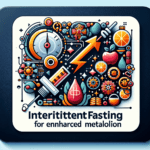So you’ve heard about intermittent fasting and how it can help with weight loss and overall health. But with so many different techniques out there, it can be overwhelming to know where to start. That’s why we’ve compiled a list of the most effective intermittent fasting techniques that are both sustainable and yield long-term success. Whether you’re a beginner or a seasoned faster, these techniques are designed to work with your lifestyle and help you achieve your health goals. From the 16/8 method to alternate-day fasting, find out which approach resonates with you and get ready to embark on a journey towards a healthier you.

Choosing the Right Intermittent Fasting Method
Intermittent fasting has gained popularity in recent years as a way to improve health, promote weight loss, and boost overall well-being. With so many different methods to choose from, it’s important to find the one that works best for you. Here are five of the most popular intermittent fasting methods:
The 16/8 Method
The 16/8 method involves an eight-hour eating window followed by a 16-hour fasting period. This approach is relatively easy to implement and can be adapted to fit your schedule. For example, you might choose to have your eating window from 12 pm to 8 pm and fast from 8 pm to 12 pm the next day. This method allows for consistency and may help regulate your hunger cues over time.
The 5:2 Diet
With the 5:2 diet, you eat normally for five days of the week and restrict your calorie intake to 500-600 calories on the remaining two days. These fasting days are not consecutive and can be spread out throughout the week. This method provides flexibility while still allowing you to experience the benefits of intermittent fasting.
Alternate Day Fasting
Alternate day fasting involves alternating between regular eating days and fasting days. On fasting days, you can either completely abstain from food or consume a limited number of calories (typically 500-600). This method may be more challenging for some individuals due to the alternating nature of the fasting and eating days, but it can be effective for weight loss and improving overall health markers.
Eat-Stop-Eat
Eat-Stop-Eat involves one or two 24-hour fasting periods each week. During these fasting periods, you abstain from all food and only consume calorie-free beverages such as water, tea, or coffee. This method can be challenging for some people, particularly those who do not tolerate longer periods of fasting well. However, it can be an effective way to reduce calorie intake and promote fat loss.
The Warrior Diet
The Warrior Diet involves a 20-hour fasting period followed by a four-hour eating window. During the fasting period, small amounts of raw fruits and vegetables, as well as protein-rich foods, are allowed. The majority of your caloric intake occurs during the four-hour eating window, typically in the evening. This method can be challenging for individuals who prefer regular meals throughout the day but may suit those who have more control over their eating habits during a shorter eating window.
Understanding the Science Behind Intermittent Fasting
Intermittent fasting works by changing the body’s metabolic state and hormonal levels, resulting in various health benefits. Here’s a breakdown of the key scientific factors behind intermittent fasting:
How Intermittent Fasting Affects Your Body
When you fast, your body transitions from using glucose as its primary energy source to burning stored fat instead. This leads to weight loss and reductions in body fat percentage. Additionally, fasting can improve insulin sensitivity, which is important for regulating blood sugar levels and preventing chronic diseases such as type 2 diabetes.
The Role of Insulin in Fasting
Insulin is a hormone that helps regulate blood sugar levels. When you eat, your body releases insulin to shuttle glucose into the cells for energy. However, high levels of insulin can lead to weight gain and insulin resistance over time. Intermittent fasting can help lower insulin levels and improve insulin sensitivity, reducing the risk of developing metabolic disorders.
The Benefits of Autophagy
Autophagy is a natural cellular process that occurs during fasting. It involves the body’s cells breaking down and recycling damaged proteins and organelles. This process helps maintain cell health and has been linked to various health benefits, including improved longevity, reduced inflammation, and protection against neurodegenerative diseases.
Establishing Realistic Goals and Expectations
Before starting any intermittent fasting regimen, it’s important to identify your motivation and set achievable goals. Here are some guidelines to help you establish realistic expectations:
Identifying Your Motivation
Understanding why you want to try intermittent fasting can help you stay committed to the process. Are you looking to lose weight, improve your overall health, or gain more control over your eating habits? Identifying your motivation will help you stay focused and committed to your intermittent fasting journey.
Setting Achievable Targets
When setting goals, it’s important to be realistic. Instead of aiming for rapid weight loss or dramatic changes overnight, focus on small, achievable targets. For example, you could aim to lose one to two pounds per week or improve your fasting blood glucose levels by a certain percentage. Setting achievable goals will make the process more manageable and sustainable in the long run.
Tracking Progress
To stay motivated and track your progress, consider keeping a journal or using a mobile app to log your fasting hours, eating habits, and any changes you notice in your body and overall well-being. This will help you see the progress you’ve made and identify areas where you may need to make adjustments.
Creating a Balanced Meal Plan
While intermittent fasting primarily focuses on when you eat, it’s important to create a balanced meal plan during your eating window to ensure you’re getting adequate nutrition. Here are some tips for designing a nutrient-rich eating window:
Designing a Nutrient-Rich Eating Window
During your eating window, aim to consume a variety of nutrient-dense foods such as fruits, vegetables, whole grains, lean proteins, and healthy fats. This will provide your body with the essential vitamins, minerals, and macronutrients it needs for optimal health and functioning.
Choosing Whole Foods
Opt for whole foods rather than processed or packaged foods whenever possible. Whole foods are more nutritious and provide a greater variety of essential nutrients. Incorporate fruits and vegetables, lean proteins, whole grains, and healthy fats into your meals to create a balanced and satisfying eating plan.
Managing Macronutrient Ratios
Depending on your goals and preferences, you may choose to focus on specific macronutrient ratios during your eating window. For example, some individuals prefer a higher protein intake to support muscle growth and recovery, while others may prioritize an increased fat intake for improved satiety. Experiment with different macronutrient ratios to find what works best for you and your body.

Optimizing Workouts and Exercise Regimens
Intermittent fasting can be incorporated into your workout routine to maximize its benefits. Here are some strategies for optimizing your workouts while fasting:
Determining the Best Workout Timing
Experiment with different workout timings to find what works best for you. Some individuals prefer exercising during their fasting period, as it can enhance fat burning. Others may find it more comfortable to work out during their eating window to ensure they have enough energy for their workouts. Listen to your body and adjust your workout schedule accordingly.
Adapting Your Routine for Fasting
If you choose to work out during your fasting period, consider focusing on low-to-moderate intensity exercises such as walking, yoga, or light resistance training. These activities can be performed without depleting your energy stores and may even enhance fat burning. Save high-intensity exercises for your eating window when you have more fuel to sustain intense workouts.
Incorporating Resistance Training and Cardiovascular Exercises
Both resistance training and cardiovascular exercises are important for overall health and fitness. Incorporate resistance training exercises, such as weightlifting or bodyweight workouts, two to three times per week to build lean muscle mass and improve strength. Additionally, aim for cardiovascular exercises like jogging, swimming, or cycling to improve cardiovascular health and endurance.
Managing Hunger and Cravings
One of the challenges of intermittent fasting is dealing with hunger and cravings during the fasting period. Here are some strategies to help manage these feelings:
Understanding the Difference between Hunger and Cravings
Hunger is a physiological response that occurs when your body needs fuel, while cravings are often triggered by emotions or external cues. Learn to differentiate between the two and address them accordingly. If you’re truly hungry, try consuming calorie-free beverages or small snacks that won’t break your fast, such as nuts or vegetables. Cravings, on the other hand, can often be managed by finding alternative distractions or opting for healthier food choices.
Strategies to Distract Yourself from Cravings
If you find yourself experiencing cravings during your fasting period, try distracting yourself with activities such as reading, going for a walk, or practicing a hobby. Keeping yourself occupied can take your mind off food and help reduce cravings.
Appetite Suppressing Foods and Drinks
Certain foods and drinks can help suppress appetite and keep you feeling full during your fasting period. Incorporate high-fiber foods like fruits, vegetables, and whole grains into your diet, as they can help you feel more satisfied. Additionally, consuming calorie-free beverages such as water, herbal tea, or black coffee can help curb hunger pangs.
Troubleshooting Common Challenges
As with any lifestyle change, intermittent fasting may come with its own set of challenges. Here’s how to overcome some common obstacles:
Overcoming Plateaus
If you find that your progress has stalled or you’ve reached a weight loss plateau, don’t get discouraged. Plateaus are a normal part of the weight loss journey. Try incorporating new exercises, adjusting your macronutrient ratios, or changing up your fasting pattern to jumpstart your progress again.
Dealing with Social Situations and Temptations
Social events and gatherings often revolve around food, making it challenging to stick to your fasting schedule. Plan ahead by bringing your own healthy snacks or eat a small meal before attending an event, so you’re less tempted to indulge. Remember to prioritize your goals and stay committed to your intermittent fasting plan.
Handling Fatigue and Lethargy
Some individuals may experience temporary fatigue or lethargy when starting intermittent fasting, particularly during the initial adaptation phase. This is often due to changes in nutrient intake and energy availability. Allow your body time to adjust to the new eating pattern, stay hydrated, and ensure you’re getting enough quality sleep to combat these symptoms.
Maintaining a Healthy Relationship with Food
Intermittent fasting should not involve restrictive eating or an unhealthy relationship with food. It’s important to maintain a balanced approach and develop mindful eating habits. Here are some tips:
Avoiding Restrictive Eating Patterns
Intermittent fasting is not meant to be an extreme or restrictive eating pattern. It should be a sustainable and enjoyable lifestyle choice. Avoid falling into the trap of strict dieting or excessive calorie restriction. Instead, focus on nourishing your body with nutrient-dense foods and appreciating the benefits that intermittent fasting can provide.
Developing Mindful Eating Habits
Pay attention to your body’s hunger and fullness cues and eat mindfully during your eating window. Avoid distractions such as screens or eating on the go. Chew your food slowly and savor each bite. This will not only help you enjoy your meals more, but it can also improve digestion and portion control.
Practicing Moderation
While intermittent fasting can be a useful tool for weight loss and overall health, it’s important to practice moderation and balance. Allow yourself occasional indulgences or treats during your eating window to satisfy cravings and prevent feelings of deprivation. Remember, sustainable habits are built on flexibility and a healthy relationship with food.
Harnessing the Power of Support and Accountability
Finding support and accountability can greatly enhance your intermittent fasting journey. Here are some ways to harness the power of support:
Finding an Intermittent Fasting Community
Join online communities or social media groups dedicated to intermittent fasting. These communities can provide support, motivation, and helpful tips for navigating the challenges of fasting. Share your experiences and learn from others who have successfully incorporated intermittent fasting into their lives.
Partnering with an Accountability Buddy
Find a friend or family member who is also interested in intermittent fasting and become accountability partners. This can involve checking in with each other, sharing meal plans, and motivating each other to stay on track. Having someone to share your journey with can make the process more enjoyable and increase your chances of success.
Utilizing Mobile Apps and Tracking Tools
There are many mobile apps and tracking tools available that can help you stay on top of your intermittent fasting regimen. These apps can help monitor your fasting hours, log your meals, and track your progress. Utilize these tools to streamline your journey and stay accountable to your goals.
Understanding Potential Risks and Consultation
While intermittent fasting can be safe and beneficial for many individuals, it’s important to assess your individual health needs and consult with a healthcare professional if necessary. Here are some considerations:
Assessing Your Individual Health Needs
Intermittent fasting may not be suitable for everyone, especially those with certain medical conditions or specific nutrient requirements. If you have any underlying health concerns, such as diabetes, heart disease, or a history of eating disorders, consult with a healthcare professional to determine if intermittent fasting is appropriate for you.
Consulting with a Healthcare Professional
If you’re unsure about starting intermittent fasting or have any concerns about your health, it’s always a good idea to consult with a healthcare professional. They can provide personalized advice and guidance based on your individual needs and help ensure you’re embarking on a safe and effective intermittent fasting journey.
Addressing Preexisting Conditions
If you do have preexisting medical conditions, it’s important to work with a healthcare professional to adapt your intermittent fasting plan to your specific needs. They can help you develop a tailored approach that takes into account your condition and any necessary modifications to ensure your well-being.
In conclusion, intermittent fasting can be a powerful tool for improving health and achieving sustainable weight loss. By choosing the right fasting method, understanding the science behind it, establishing realistic goals, creating a balanced meal plan, optimizing workouts, managing hunger and cravings, troubleshooting challenges, maintaining a healthy relationship with food, harnessing support and accountability, and considering potential risks, you can embark on a successful intermittent fasting journey. Remember to listen to your body, stay committed to your goals, and seek professional guidance when needed.








